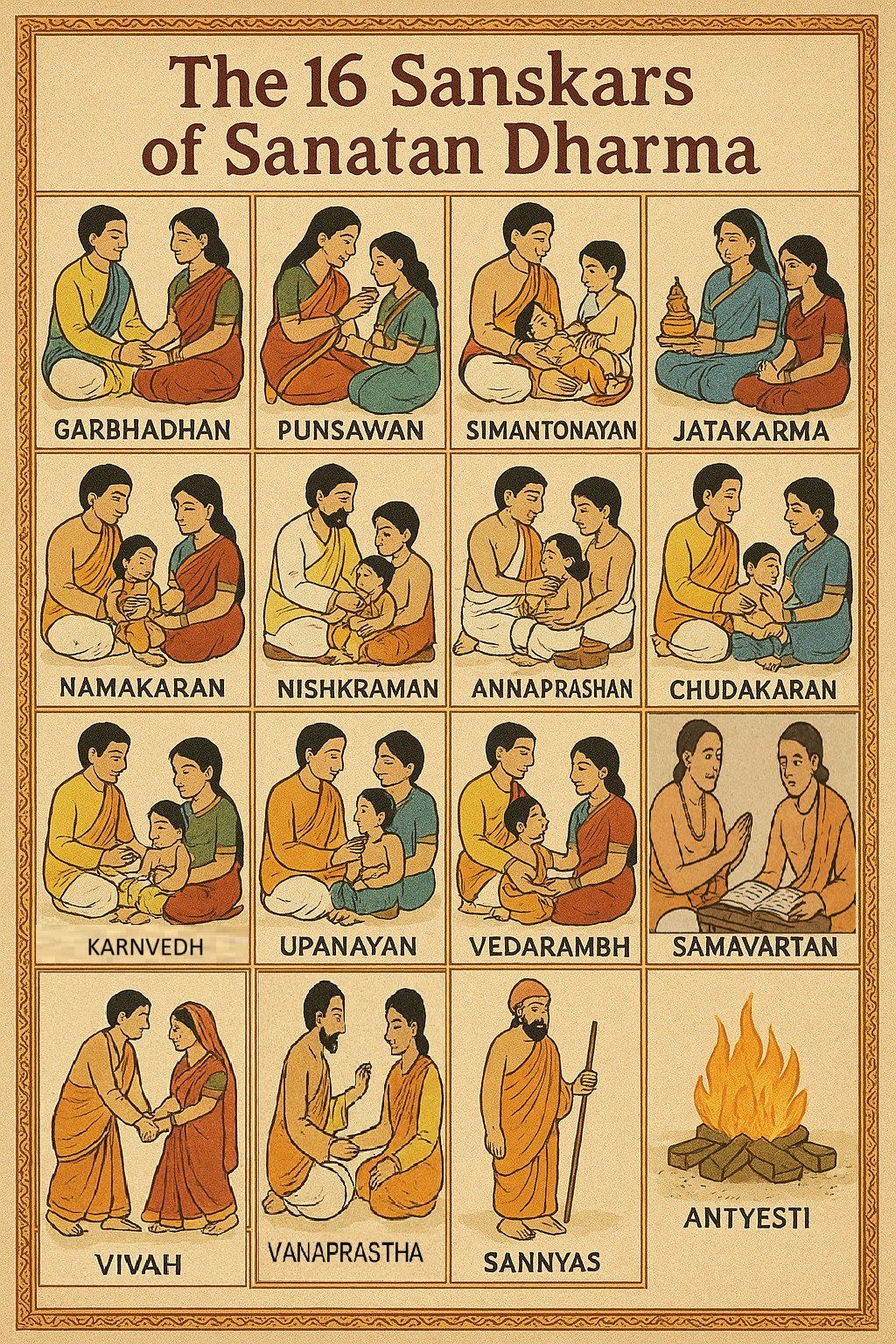🕉️ The 16 Sanskars of Sanatan Dharma
A Journey of the Soul through Sacred Milestones of Life
Sanatan Dharma, the eternal way of life, offers a structured path for spiritual, emotional, intellectual, and physical evolution. One of the foundational pillars of this path is the observance of 16 Sanskars (Ṣoḍaśa Saṁskāra) — sacred rites of passage designed to elevate a human being's journey from conception to death.
These Sanskars are described in the Vedas, Smritis, and Dharmashastras, acting as cultural and spiritual touchstones throughout one’s life. They aren’t just rituals, but moments that transform the mundane into the divine — aligning an individual with Dharma (duty), Artha (purpose), Kama (desire), and ultimately, Moksha (liberation).
Let us explore each Sanskar in depth:
👶 1. Garbhadhana (Conception)
Meaning: "Womb Placement"
Purpose: To purify the act of conception and invoke divine blessings for a noble soul.
Details: This ritual is performed by the couple with spiritual intent, praying for virtuous offspring. It affirms that life begins not just biologically but as a sacred act with cosmic responsibility.
🤰 2. Pumsavana (Fetus Nourishment)
Timing: Between 2nd and 4th month of pregnancy
Purpose: For the well-being of the fetus and to ensure a healthy birth.
Details: Mantras are chanted, and herbal concoctions are given to the mother. Though misunderstood at times, its purpose is spiritual—not gender determination, but the invocation of divine qualities in the unborn.
🪮 3. Simantonnayana (Hair-Parting Ceremony)
Timing: 6th to 8th month of pregnancy
Purpose: To bless the expecting mother with strength and mental well-being.
Details: The husband parts the hair of his wife, symbolizing love and care. This ritual affirms social and emotional support for the pregnant woman.
👶 4. Jatakarma (Birth Ceremony)
Timing: Immediately after birth
Purpose: Welcoming the soul to the world
Details: Honey and ghee are given to the newborn. Sacred mantras are whispered in the baby's ear, symbolizing the awakening of consciousness and wisdom.
🧑🍼 5. Namkaran (Naming Ceremony)
Timing: 11th or 12th day after birth
Purpose: To give an identity to the soul
Details: The baby is named based on astrology and family traditions. The name is believed to influence the destiny and nature of the child.
🌞 6. Nishkramana (First Outing)
Timing: Around the 4th month
Purpose: Introduction to the outside world
Details: The baby is taken out to view the sun, moon, and sacred fire — initiating their connection with the natural and divine cosmos.
🍚 7. Annaprashana (First Solid Food)
Timing: 6th month
Purpose: The child’s first experience with food beyond milk
Details: Rice and other solid foods are ceremonially introduced, typically by the father or grandfather. It signifies growth and sustenance.
✂️ 8. Chudakarana (First Haircut)
Timing: 1st or 3rd year
Purpose: Shedding past karma
Details: The first hair is believed to carry birth impurities. Cutting it is symbolic of starting afresh on a path of dharma and cleanliness.
👂 9. Karnavedha (Ear Piercing)
Timing: Childhood
Purpose: Awakening energy channels (nadis)
Details: Both boys and girls undergo this. It’s said to stimulate brain functions and activate inner awareness. It also prepares the child for wearing ornaments like kundals (earrings).
📖 10. Vidyarambha (Beginning of Education)
Timing: Around 5 years
Purpose: Formal initiation into learning
Details: The child writes their first letters, often beginning with ‘Om’ or ‘Sri Ganeshaya Namah’. Marks the start of spiritual and intellectual journey.
🧵 11. Upanayana (Sacred Thread Ceremony)
Purpose: Initiation into Brahmacharya (student life)
Details: Also called "Yajnopavita", it’s mostly for boys from Brahmin, Kshatriya, and Vaishya castes. It signifies accepting the teacher (Guru) and a life of discipline and learning.
📚 12. Vedarambha (Beginning of Vedic Study)
Purpose: Start of spiritual education
Details: The child begins studying Vedas and scriptures under a guru’s guidance. Chanting and memory training begin — building intellect and character.
🎓 13. Samavartana (Graduation)
Purpose: Completion of Brahmacharya Ashram
Details: The student returns from Gurukul, ready to enter Grihastha (householder) life. It includes rituals of purification, charity, and gratitude to the Guru.
💍 14. Vivaha (Marriage)
Purpose: Entering Grihastha Ashram (householder life)
Details: One of the most important Sanskars. Vivaha is a sacred bond of duty, love, and growth. It unites two souls spiritually, emotionally, and socially for dharmic purposes.
🌳 15. Vanaprastha (Retirement from Worldly Duties)
Timing: Later years (after fulfilling worldly responsibilities)
Purpose: To detach and focus on spiritual pursuits
Details: The person renounces material life, lives in nature, and begins meditative practices. It symbolizes renunciation without abandoning duties.
🧘♂️ 16. Antyeshti (Last Rites/Funeral)
Purpose: Final purification and release of the soul
Details: Includes cremation, ash immersion, and Shraddha rituals. Meant to ensure the soul’s smooth journey to the afterlife or rebirth. Family performs rites for peace and moksha of the departed.
🙏 Conclusion: A Divine Framework for Life
The 16 Sanskars are not just religious rituals — they are soul-sculpting ceremonies that elevate every aspect of human life. In Sanatan Dharma, these rituals offer an evolutionary path to navigate body, mind, and soul across various ashramas (life stages):
Brahmacharya (student)
Grihastha (householder)
Vanaprastha (retired)
Sannyasa (renunciate)
They help align human life with Dharma, cultivate values, offer spiritual progression, and ensure that one lives consciously and purposefully.



Awesome 👏
Amazing culture. Good to learn. Thank you